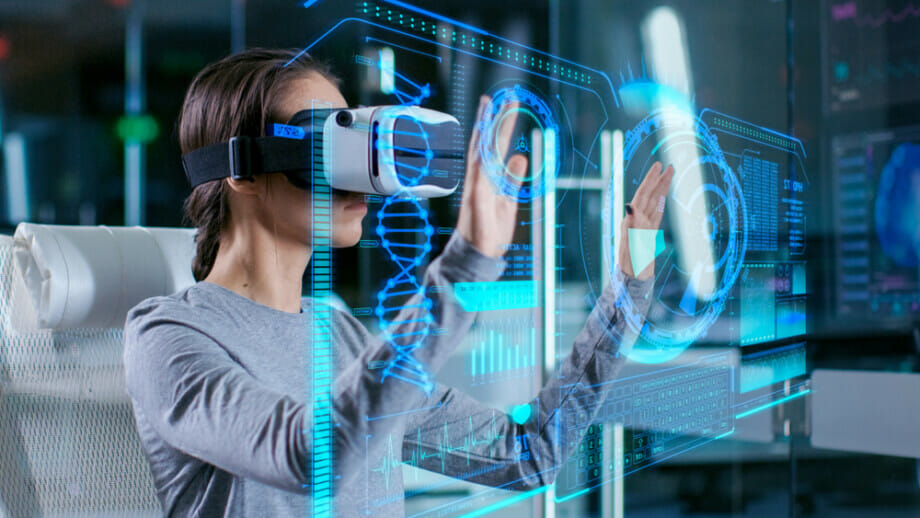
Applications in the field of augmented reality are developing from a niche phenomenon to an influential future technology: by 2030, products and services based on virtual and augmented reality could contribute 1.5 trillion US dollars to the global economy, in Germany in the amount of 104 billion US dollars.
With a worldwide turnover of 1.5 trillion US dollars in the field of augmented reality, this would correspond to an increase in GDP of 2.5 percent. In addition, 400,000 people in Germany and 23 million worldwide will work with AR/VR solutions. These are the findings of a new PwC analysis that examines the possible effects of VR/AR on the economy and employment.
“From the healthcare sector to production, trade and the consumer goods industry, all sectors will benefit from virtual and augmented reality. Because VR and AR technologies are not only well suited to make processes and procedures more efficient, but also the way people work together,“ comments Werner Ballhaus, Head of Technology, Media and Telecommunications at PwC Germany.
Augmented Reality: by 2030, 23 million jobs worldwide will be influenced by AR/VR
The analysis shows that technologies for virtual and augmented reality will also have a significant impact on employment: currently, around 824,000 jobs worldwide are directly influenced by VR and AR. By 2030, the number of people working with AR/VR could increase to 23.4 million. In Germany, every 100 would come. Employees, a total of around 400,000 people, are in contact with this innovative technology at the workplace; today there are already 15,000.
“Business, economy and society
are at a crucial point in the use of virtual and
augmented reality. The technology and hardware are finally mature. PRC
and AR can now develop their potential and not only boost the economy
but also the way organizations work,
revolutionize: Processes run more efficiently, employees can
more effective training“”says Werner Ballhaus.
These areas and industries are particularly
a lot of applications from the field of
benefit from virtual and augmented reality:
- The development of products and services is facilitated thanks to AR and VR technologies, thereby contributing to global GDP with an increase of $ 359 billion.Companies are able to work together in virtual environments through AR and VR – which saves a lot of time and money.
- In the global health sector according to the analysis, AR and VR technologies will provide an increase in GDP in the amount of $ 351 billion. Virtual reality is already being used today in the training of doctors in order to let them participate in operations up close, without them being in the operating room themselves.
- In the field of continuing education and development the use of augmented and virtual reality will contribute about $ 294 billion to global GDP. With AR and VR, for example, very realistic training scenarios can be simulated without risks.
- VR and AR offer the possibility ofto improve the efficiency, productivity and accuracy of employees and processes. The PwC experts estimate the potential in this area to be around 275 billion US dollars by 2030. For example, engineers can receive real-time information via an AR interface to quickly identify problems and carry out repairs quickly.
- In the field of gaming, many people are I have already come into contact with virtual and augmented reality. The technology also offers great potential in retail, for example in the form of virtual changing rooms or applications. For the entire retail and consumer goods industry, VR/AR applications represent a potential of 204 billion US dollars.
Focus on pilot projects and business-critical problems
“Companies should support the development of VR and
Pursue AR technologies with high priority. Who is this development
failure to do so risks a competitive disadvantage,“ according to the assessment of
Werner Ballhaus. From his point of view, it makes sense to focus on the solution of business-critical
To focus on problems, such as improving safety, reducing
the cost or acceleration of product development. Let it be
it is particularly important to put the users of the applications in the center and to create a
create a positive, seamless user experience.
“Only those who have seen with their own eyes how virtual and augmented reality work in practice can be convinced of the strengths of this innovative technology. That’s why companies should start a pilot project as soon as possible and then explore the potential step by step,“ concludes PwC expert Werner Ballhaus.
Share the message “Augmented Reality: 400,000 people will be working with AR technologies in Germany by 2030” with your contacts:








